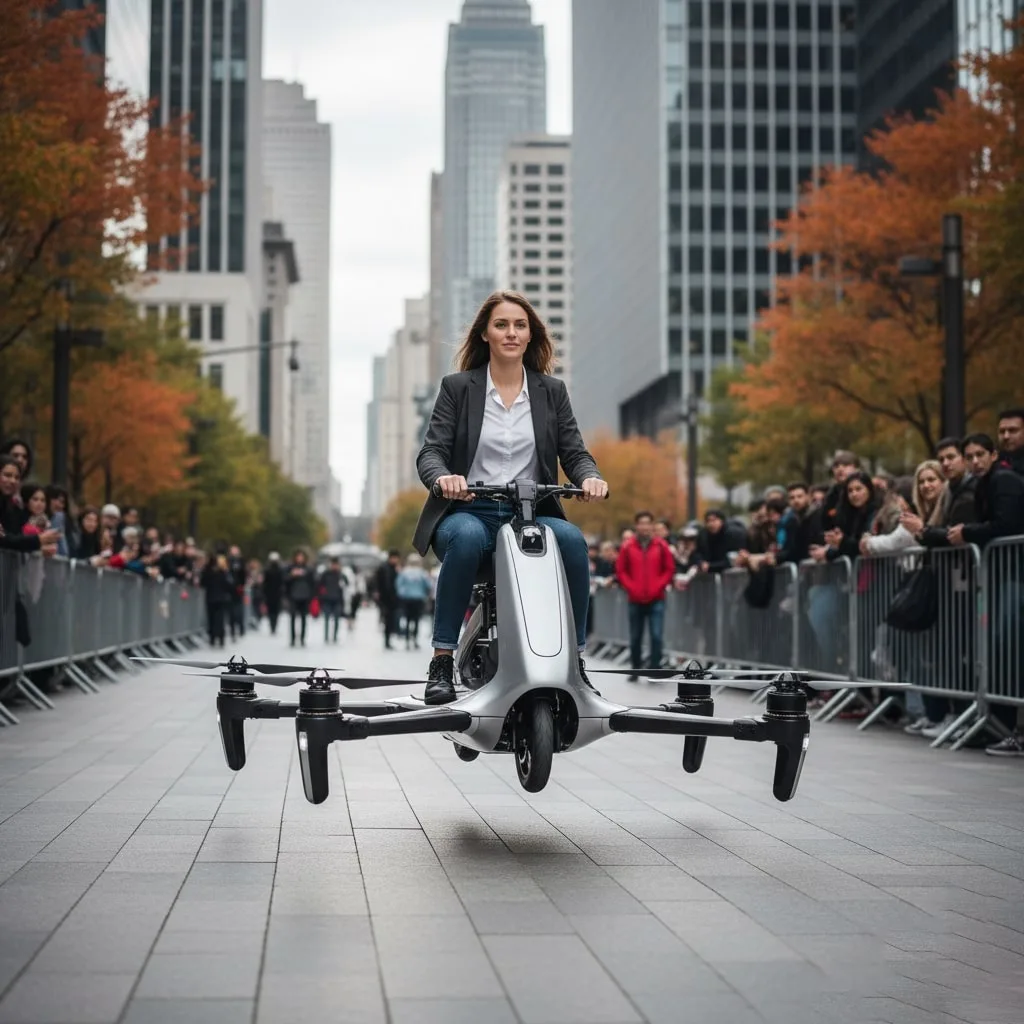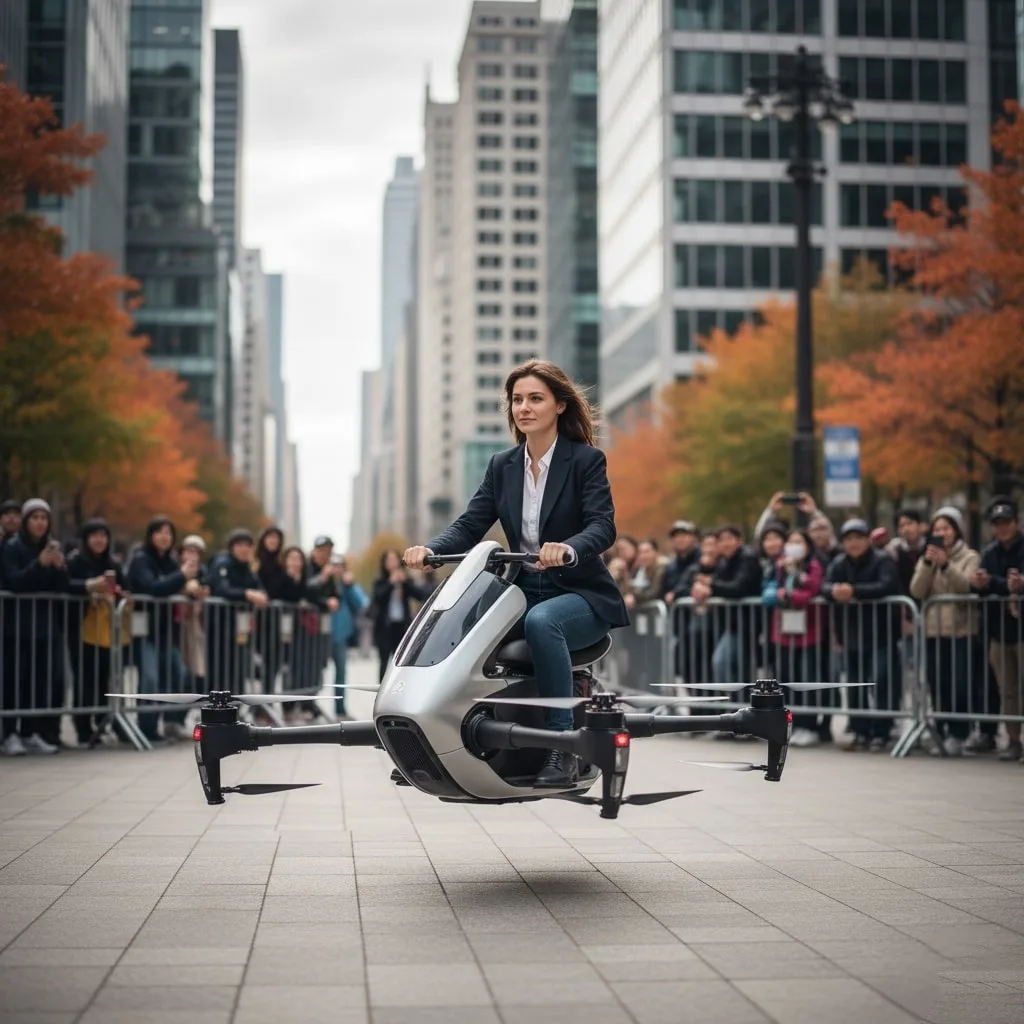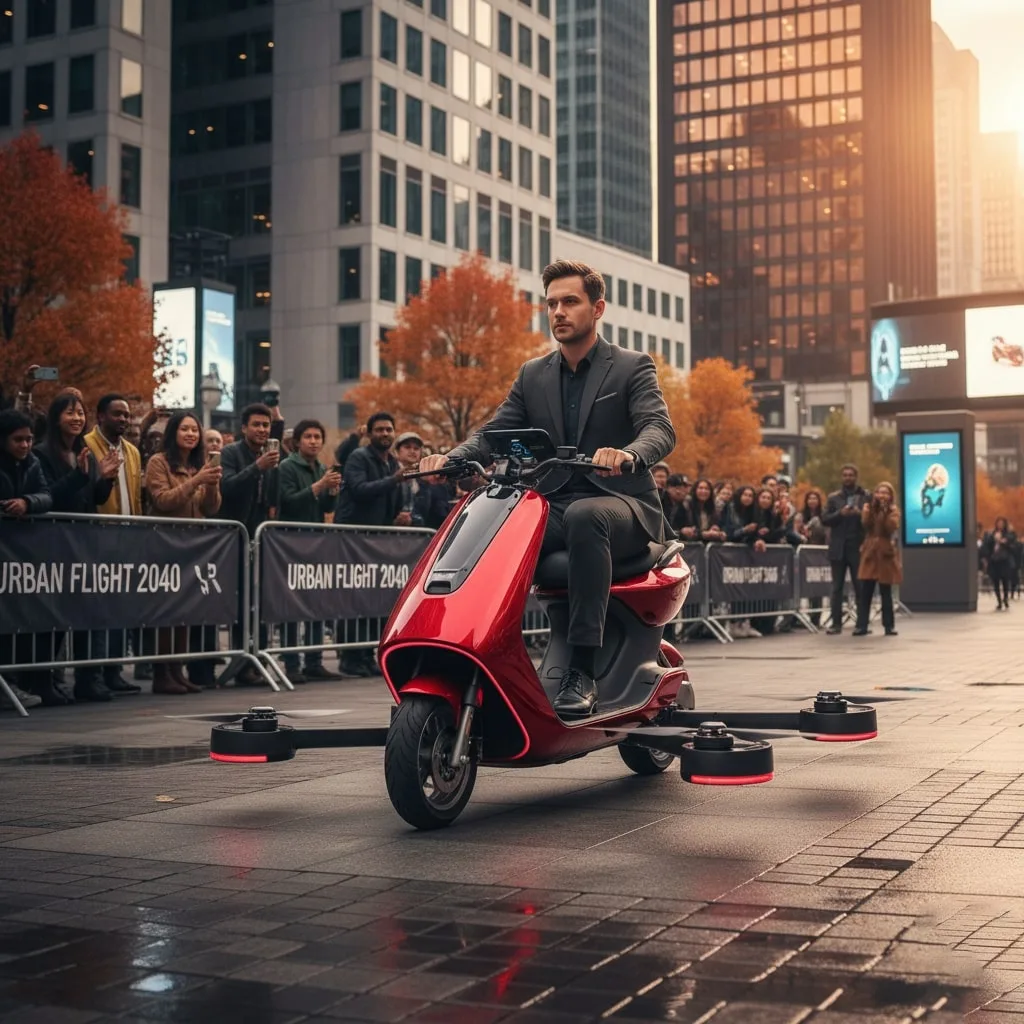The world of personal transportation is undergoing a remarkable transformation. While electric scooters have become a familiar sight in cities worldwide, a new innovation is capturing the imagination of engineers, entrepreneurs, and urban planners alike. Scooter drones represent an ambitious leap forward in how we think about moving through our increasingly crowded cities.
These innovative vehicles combine the convenience and accessibility of traditional electric scooters with cutting edge drone technology, creating hybrid solutions that could redefine urban mobility. As cities grow taller and streets become more congested, the concept of personal vehicles that can seamlessly transition between ground and air travel is no longer confined to science fiction.
Understanding the Scooter Drone Concept
At their core, scooter drones are engineered to solve a fundamental problem facing modern cities: limited space and increasing congestion. These vehicles integrate electric propulsion systems with vertical takeoff and landing capabilities, allowing riders to navigate both traditional roadways and airspace when conditions permit.
The technology behind these vehicles draws from two well established industries. Electric scooters have proven themselves as practical, eco friendly solutions for short distance urban travel. Meanwhile, drone technology has advanced dramatically in recent years, with improvements in battery efficiency, motor power, and flight control systems making previously impossible concepts suddenly viable.
What makes scooter drones particularly intriguing is their potential versatility. Unlike purely ground based vehicles, they offer the possibility of bypassing traffic entirely during peak hours. Unlike conventional aircraft or even larger flying cars, they maintain the compact, user friendly form factor that has made electric scooters so popular with urban commuters.
The Technology Powering These Innovations

The engineering challenges involved in creating functional scooter drones are substantial. Designers must balance competing priorities including weight, battery capacity, safety systems, and aerodynamic efficiency. Modern prototypes incorporate sophisticated flight control systems similar to those found in commercial drones, but scaled up to safely carry human passengers.
Battery technology represents one of the most critical components. Current lithium ion batteries must provide enough power for both ground travel and flight modes, while remaining light enough to make flight practical. Engineers are constantly working to improve energy density, with some experimental models exploring solid state batteries and other emerging technologies.
The propulsion systems typically feature multiple rotors arranged to provide stable lift and precise control. These configurations allow for vertical takeoff and landing, eliminating the need for runways. Advanced sensors and automated flight control systems help maintain stability, compensate for wind conditions, and assist riders who may have no previous flight experience.
Safety mechanisms are paramount in these designs. Redundant systems ensure that if one component fails, others can compensate. Emergency landing protocols, obstacle detection sensors, and automated return to ground functions are all standard considerations in serious prototype development.
Real World Applications and Use Cases

The practical applications for scooter drones extend across numerous scenarios. Urban commuters represent the most obvious market, particularly those facing lengthy commutes through congested areas. The ability to rise above street level traffic, even for short segments of a journey, could dramatically reduce travel times during rush hours.
Emergency response represents another compelling application. First responders could use these vehicles to quickly reach accident scenes or medical emergencies, bypassing ground traffic entirely. In areas with limited road infrastructure, scooter drones could provide crucial transportation links that would be impossible or prohibitively expensive to establish using traditional methods.
Tourism and recreation offer additional opportunities. Scenic flights over urban landscapes or natural areas could become accessible to broader audiences. Theme parks and entertainment venues might incorporate these vehicles into attractions, giving visitors unique aerial perspectives in controlled environments.
Delivery services are exploring how scooter drone technology might enable more efficient last mile logistics. Rather than navigating congested streets, delivery personnel could take direct routes through designated air corridors, potentially revolutionizing how goods move through dense urban areas.
Current Market Developments and Prototypes

Several companies and research institutions are actively developing scooter drone prototypes. These projects range from concept designs to functional vehicles that have completed successful test flights. Each takes a slightly different approach to solving the fundamental challenges inherent in creating a practical, safe, and affordable personal air vehicle.
Some designs emphasize the scooter aspect, essentially creating electric scooters with deployable rotors that enable brief flights over obstacles or across gaps in infrastructure. Others lean more heavily toward drone capabilities, creating small personal aircraft with scooter like controls and a compact footprint suitable for urban environments.
Japanese engineers have showcased hoverbike designs that incorporate scooter ergonomics with quadcopter flight systems. European startups are experimenting with hybrid models that can operate in pure electric scooter mode for maximum efficiency, switching to flight mode only when necessary. American companies are developing sophisticated flight control software that could make piloting these vehicles as intuitive as riding a traditional scooter.
The regulatory landscape is evolving alongside these technological developments. Aviation authorities worldwide are establishing frameworks for personal air vehicles, defining where and how they can operate safely alongside traditional aircraft, buildings, and ground traffic.
Benefits and Advantages of Hybrid Transportation

The potential benefits of scooter drones extend well beyond simple convenience. From an environmental perspective, electric powered flight produces zero direct emissions, contributing to cleaner urban air quality. As electricity grids incorporate more renewable energy sources, the carbon footprint of these vehicles continues to decrease.
Time savings represent perhaps the most immediate and tangible benefit for users. The ability to bypass congested streets could transform commutes that currently take an hour into fifteen minute journeys. This efficiency could improve quality of life for millions of urban residents while reducing the collective time lost to traffic congestion.
Urban planning could benefit from reduced pressure on street level infrastructure. If significant numbers of commuters adopt air capable vehicles, cities might require fewer lanes of traffic, freeing space for parks, pedestrian areas, or other community uses. The vertical dimension of travel opens entirely new possibilities for how cities organize transportation networks.
Accessibility is another important consideration. For people with mobility challenges, or those living in areas with poor road connectivity, scooter drones could provide independence and opportunities that traditional transportation options cannot match. Remote or underserved communities might leapfrog conventional infrastructure development, much as mobile phones allowed many regions to bypass landline networks.
Challenges and Obstacles to Overcome

Despite their promise, scooter drones face substantial hurdles before they can become mainstream transportation options. Safety concerns naturally top the list. Any vehicle that operates in three dimensional space above populated areas must meet extraordinarily high reliability standards. The consequences of mechanical failure are potentially catastrophic, requiring multiple redundant systems and rigorous testing protocols.
Noise pollution presents another significant challenge. Current drone propulsion systems generate considerable noise, which could become intolerable if thousands of vehicles were buzzing overhead. Engineers are exploring quieter motor designs, optimized rotor configurations, and flight path planning that minimizes disturbance to residents and wildlife.
Battery limitations remain a fundamental constraint. While battery technology continues improving, current systems still limit flight times and range considerably. Most prototype scooter drones can sustain flight for only ten to twenty minutes, restricting their practical utility. Breakthrough advances in energy storage will be necessary before these vehicles can serve as primary transportation for most users.
Cost represents a substantial barrier to adoption. Current prototypes are expensive to manufacture, with price points that place them far beyond average consumer budgets. Economies of scale and manufacturing improvements will need to bring costs down dramatically before scooter drones become accessible to mainstream markets.
The regulatory environment is still taking shape. Governments must balance innovation and economic opportunity against legitimate safety and privacy concerns. Establishing air corridors, altitude restrictions, licensing requirements, and liability frameworks will take years of careful policy development and stakeholder negotiation.
The Role of Artificial Intelligence and Automation

Advanced artificial intelligence systems will play crucial roles in making scooter drones practical and safe. Autonomous flight capabilities could handle the complex moment to moment adjustments required for stable flight, allowing riders to focus on navigation and destination rather than technical piloting tasks.
AI powered collision avoidance systems will be essential in environments where multiple vehicles share airspace. These systems must detect and respond to obstacles, other vehicles, birds, and changing weather conditions in real time. Machine learning algorithms can continuously improve performance based on accumulated flight data from thousands of vehicles.
Traffic management systems leveraging AI could coordinate the movements of numerous scooter drones simultaneously, optimizing routes to minimize congestion and prevent conflicts. These systems might function similarly to air traffic control, but operating at much faster speeds and managing far more vehicles in much smaller spaces.
Predictive maintenance represents another valuable application of artificial intelligence. By analyzing data from sensors throughout the vehicle, AI systems can identify potential mechanical issues before they become failures, scheduling maintenance proactively and preventing accidents.
Environmental Considerations and Sustainability

The environmental impact of scooter drones depends heavily on how they are powered and manufactured. Electric propulsion eliminates direct emissions during operation, but the electricity must come from clean sources to realize the full environmental benefits. As renewable energy becomes more prevalent, the carbon footprint of these vehicles will continue improving.
Manufacturing processes and material choices significantly affect overall sustainability. Lightweight materials like carbon fiber and specialized aluminum alloys reduce energy requirements during flight but often have substantial environmental costs during production. Manufacturers are exploring recycled materials, bio based composites, and closed loop manufacturing processes to minimize environmental impact.
End of life considerations are equally important. Batteries, motors, and electronics must be designed for eventual recycling or safe disposal. The most environmentally responsible designs will incorporate modularity, allowing components to be easily replaced, upgraded, or recycled as technology advances.
Noise and wildlife impacts require ongoing study and mitigation. Bird strikes pose risks to both the animals and vehicle occupants. Flight path planning that avoids sensitive habitats and migration routes will be necessary. Researchers are also investigating whether the noise and presence of numerous flying vehicles might affect urban wildlife populations.
What the Future Holds
Looking ahead, scooter drones may represent just the beginning of a broader transformation in personal transportation. As technology matures and costs decline, these vehicles could become as common as bicycles or traditional scooters are today. Cities might develop extensive three dimensional transportation networks with designated air lanes at various altitudes.
Integration with other transportation modes will be key to widespread adoption. Imagine seamlessly transitioning from a subway to a scooter drone for the last mile of your commute, all coordinated through a single app. This kind of multimodal integration could make car ownership unnecessary for many urban residents.
The technology developed for scooter drones will likely influence other transportation innovations. The same propulsion systems, batteries, and control software could power larger flying taxis, cargo drones, or emergency vehicles. The lessons learned from early scooter drone deployments will inform the entire emerging urban air mobility industry.
Social and cultural changes may prove as significant as the technological advances. Growing up with flying vehicles as a normal part of the transportation landscape will shape how future generations think about travel, urban space, and personal mobility. The mental maps we use to navigate cities could expand from two dimensions to three.
Bringing Innovation Down to Earth
The journey from concept to widespread adoption for scooter drones will be long and filled with challenges. Yet the potential rewards justify the effort. These innovative vehicles represent more than just a novel way to get around. They embody a reimagining of urban mobility that addresses real problems facing growing cities worldwide.
Success will require collaboration among engineers, policymakers, urban planners, and communities. Technology alone cannot ensure that scooter drones become a positive addition to our transportation ecosystem. Thoughtful regulation, inclusive planning processes, and ongoing attention to safety, accessibility, and environmental impact will all be necessary.
The companies and researchers working on scooter drones today are not just building vehicles. They are laying the groundwork for a transformation in how humans move through space. Whether that transformation unfolds quickly or gradually, whether these specific designs succeed or inspire better alternatives, the fundamental idea has captured imaginations around the world.
For urban commuters tired of sitting in traffic, for emergency responders seeking faster ways to reach people in need, for anyone who has ever looked at the sky and imagined a more direct route to their destination, scooter drones offer a tantalizing glimpse of what might be possible. The age of personal flight may still be on the horizon rather than overhead, but it is coming closer with each technological breakthrough and successful test flight.
The revolution in urban transportation has begun, and scooter drones are helping to lead the way into an era where the sky is no longer the limit but the pathway forward.

